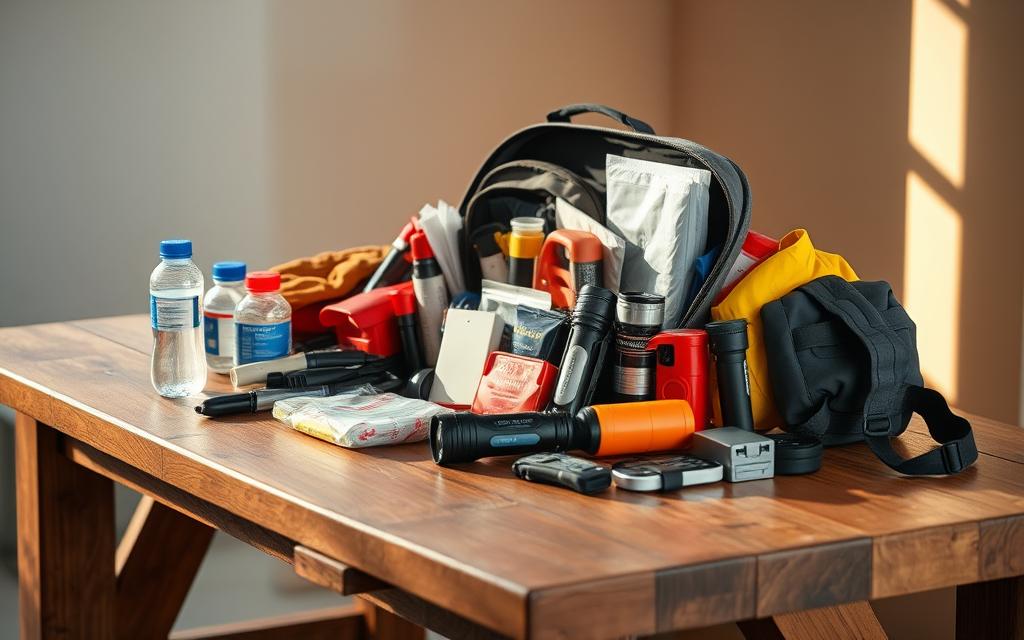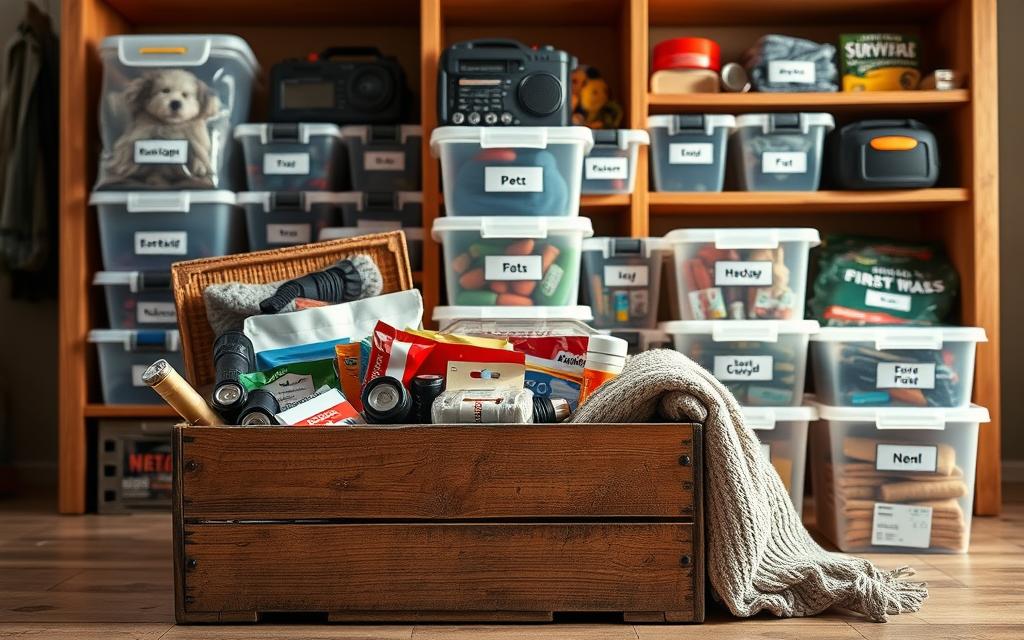Life can surprise us, but staying prepared doesn’t have to be complicated. A well-organized collection of essentials helps you handle unexpected events with confidence. Whether it’s a sudden storm or a power outage, having the right tools on hand makes all the difference.
Start by choosing a sturdy container like a duffel bag or plastic bin. These options keep your supplies dry and easy to grab. Focus on basics: aim for one gallon of water per person daily, non-perishable snacks, and a manual can opener. Don’t forget a battery-powered radio and extra batteries to stay informed if networks go down.
First aid materials are non-negotiable. Bandages, pain relievers, and prescription meds should top your list. Toss in hygiene products like hand sanitizer and moist towelettes—they’re lifesavers when clean water is scarce.
Keep critical documents—IDs, insurance papers, medical records—in a waterproof pouch. Store everything in a designated place everyone in your household knows. Set reminders every few months to refresh expired items and adjust for changing needs.
Preparation isn’t about fear; it’s about empowerment. With a little effort today, you’ll build peace of mind for whatever tomorrow brings.
Understanding the Need for Emergency Preparedness
Unpredictable events remind us that preparation is the key to resilience. Organizations like FEMA stress that having a well-stocked supply at home, work, and in your car reduces risks during sudden crises. This isn’t about expecting the worst—it’s about creating a safety net for your family when plans change.

Modern challenges like extreme weather or power outages highlight why accurate information matters. A thoughtfully assembled collection of items ensures you can act quickly instead of scrambling. Start by choosing a durable bag or container that’s easy to grab—visibility and accessibility save precious time.
Regularly updating your emergency resources keeps them aligned with evolving needs. Check expiration dates every few months and adjust for new scenarios. Remember: preparedness isn’t a one-time task. It’s an ongoing commitment to protecting what matters most.
Essential Components of an Emergency Kit
Being ready starts with knowing what to pack. Your survival supplies should cover three core areas: hydration, nourishment, and safety. Tailor quantities to your household size and local risks like extreme weather patterns.

Water, Food, and Sanitation Supplies
Plan for one gallon of water per person daily—store enough for at least three days. Choose compact, nutrient-dense food like energy bars or canned goods. A manual can opener is a must.
Include garbage bags, disinfectant sprays, and portable toilets. These items prevent contamination when plumbing fails. Seal everything in airtight containers to avoid spoilage.
First Aid and Communication Tools
Stock adhesive bandages, antiseptic wipes, and prescription meds. Add a laminated list of emergency contacts and allergies. A hand-crank radio keeps you updated if cell towers fail.
Check expiration dates every six months. Rotate seasonal gear like blankets or cooling towels based on forecasts. Store your bag in a cool, dry spot everyone can reach quickly.
Building Your Emergency Kits for Survival
Creating a reliable survival collection requires smart planning and sturdy gear. Follow these steps to build a system that works when you need it most.

Step-by-Step Assembly Instructions
- Gather essentials first: Start with three days’ worth of water (one gallon per person) and non-perishable meals. Add a manual can opener and protein-rich snacks.
- Organize by priority: Place first-aid materials in labeled pouches. Keep medications and hygiene products in sealed plastic bags to prevent moisture damage.
- Test functionality: Check flashlight batteries monthly and replace expired items every six months. Pack a hand-crank radio for updates during outages.
Choosing the Right Containers
- Use heavy-duty plastic bins or water-resistant duffel bags with multiple compartments
- Label sections clearly—hydration, nourishment, safety tools
- Include silica gel packets to combat humidity in airtight storage
Smart Resource Integration
Experts at EmergencyKits.com recommend laminated checklists for quick inventory reviews. Store backup power banks and solar chargers in outer pockets for easy access. Waterproof pouches protect critical documents like insurance papers and ID copies.
Rotate seasonal items like thermal blankets or cooling towels every three months. A well-organized system ensures every family member knows where to find lifesaving supplies instantly.
Customizing Your Kit: Addressing Family and Pet Needs
Every household has unique requirements that generic supplies can’t fully cover. Tailoring your preparedness tools ensures everyone—from toddlers to grandparents—stays safe and comfortable during unexpected events.

Customizing Items for Children, Seniors, and Pets
Kids need familiar snacks, coloring books, or small toys to reduce stress. For infants, include formula and extra diapers. Seniors often require hearing aid batteries or mobility aids like canes. Pets? Pack their favorite food, collapsible bowls, and a spare leash.
Don’t forget comfort items. A favorite blanket or stuffed animal helps calm anxious children. Older adults might need magnifying glasses or pill organizers. Always add a recent photo of each family member and pet in case you get separated.
Considering Special Medications and Unique Requirements
Prescription refills and medical devices like inhalers or glucose monitors are critical. Work with healthcare providers to store extra doses safely. Keep copies of insurance cards and vaccination records in waterproof sleeves.
Create a checklist to track personalized needs:
- Pet vaccination records and microchip details
- Allergy-friendly snacks for sensitive diets
- Extra eyeglasses or contact lens solution
Store these specialized supplies in brightly colored pouches for quick access. Review your list every season to match changing health needs or new family additions.
Maintaining and Updating Your Supply Kits
Your preparedness efforts don’t end once the kit is assembled—they evolve. Staying ahead of expiration dates and changing needs ensures your supplies remain reliable when seconds count. Think of it like checking smoke alarms: quick, routine actions with big safety payoffs.

Regular Inspection and Replacement of Expired Items
Set calendar reminders every six months to review your stockpile. Toss canned goods showing rust or bulging lids. Swap old batteries in flashlights and radios. Medications? Check dates and replace anything nearing expiration.
Keep a laminated checklist inside your container:
- Rotate water bottles annually
- Update contact lists and insurance documents
- Test backup power sources monthly
Tips for Consistent Kit Upkeep
Store similar items together using clear pouches or labeled bins. This makes spotting gaps easier. Add newer products like water purification tablets or compact solar chargers as they become available.
Involve your family during refreshes. Kids can help check snack expiration dates while adults verify medical records. Store everything in a cool closet near your home’s main exit for quick access.
Experts at Ready.gov recommend pairing kit updates with daylight saving time changes. This simple habit keeps your preparedness sharp without extra effort. Remember: small tweaks today prevent big headaches tomorrow.
Where to Store Emergency Kits: Home, Work, and Car Essentials
Being prepared isn’t just what you have—it’s where you keep it. Smart storage ensures your supplies stay protected and ready for action. Let’s explore how to position your resources for maximum effectiveness across daily environments.
Choosing Optimal Home Storage Locations
Store home kits near exits like mudrooms or under beds. Avoid basements prone to flooding. Use labeled, waterproof bags that stand out visually. FEMA recommends keeping one kit per floor if you live in a multi-level house.
- Top closet shelves work if easily reachable
- Avoid garages with extreme temperature swings
- Teach all family members where kits live
Preparing Kits for Work and On-the-Go Scenarios
Compact versions for offices should fit in desk drawers. Include protein bars, spare medications, and a mini flashlight. For car storage, use trunk organizers that won’t roll during sudden stops. EmergencyKits.com suggests adding ice scrapers and jumper cables regionally.
Ensuring Easy Accessibility in Crisis Situations
Conduct quarterly drills to test grab-and-go speed. Store water bottles and first-aid items in outer pockets. Use color-coded lists taped inside lids for instant inventory checks. Rotate seasonal gear like sunscreen or hand warmers every three months.
Remember: Your storage place should match your lifestyle. A teacher might keep a kit in their classroom cabinet, while a commuter prioritizes car readiness. Consistent organization turns scattered supplies into a lifeline you can trust.
Utilizing Preparedness Kits in Varied Emergency Scenarios
When disaster strikes, your preparation choices determine outcomes. A flexible collection of supplies adapts to floods, wildfires, or ice storms—each requiring unique adjustments. For example, during Hurricane Laura, families with waterproof radio units stayed informed despite power failures. Owlie Skywarn’s case studies show how quick thinking and adaptable resources save lives.

Adapting to Different Weather and Disaster Events
Extreme weather demands smart kit tweaks. In wildfires, add N95 masks to combat poor air quality. Floods? Elevate food and documents in waterproof bins. The 2021 Texas freeze proved the value of portable heaters and insulated blankets—items not always in standard kits.
Car-ready versions shine during sudden tornadoes. A Missouri family survived being stranded by relying on their vehicle’s water stash and jumper cables. Rotate seasonal items like sunscreen or hand warmers every three months to stay relevant.
Real-World Examples and Case Studies
After a derecho knocked out Iowa’s power grid for weeks, households with solar chargers and canned meals fared best. Owlie Skywarn’s flood preparedness program highlights waterproof phone cases and pet carriers as game-changers. One participant shared how a collapsible bowl saved their dog during evacuation.
Follow FEMA’s step-by-step guidance to build a reliable system. Test your kit quarterly—replace expired batteries and update contact lists. Remember: adaptability turns generic items into lifelines when plans unravel.
Expert Tips from Leading Emergency Prep Programs
Trusted programs offer battle-tested strategies to strengthen your readiness. The Better Business Bureau-accredited EmergencyKits.com recommends starting with government-approved checklists for reliability. Their top-rated products align with FEMA guidelines, ensuring no critical items get overlooked.
Owlie Skywarn’s research shows rotating batteries every six months prevents device failures. Store them in original packaging to avoid corrosion. For flashlights, use lithium options—they last longer in storage than alkaline.
Keep a laminated contact card with local hospitals, utility companies, and out-of-state relatives. Apps like Red Cross Emergency provide real-time alerts, but always have a paper backup. Cross-check numbers during seasonal kit updates.
When evaluating products, prioritize those with BBB accreditation or verified buyer reviews. Look for durability testing details and warranty coverage. One user shared how a $15 radio from a highly-rated brand outperformed pricier models during a blackout.
Blend these professional insights with your household’s unique needs. A teacher might add classroom evacuation maps, while hikers include topographic guides. Smart prep isn’t about copying checklists—it’s building systems that work when you need them most.
Conclusion
Taking charge starts with simple, actionable steps. Assembling a reliable collection of supplies ensures you’re ready when life shifts unexpectedly. Focus on basics like one gallon of water per person daily, non-perishable meals, and tools for communication. Customize your pack with medications, pet needs, or child-friendly items—adaptation is key.
Review your gear every six months. Swap expired batteries, refresh documents, and adjust for seasonal weather risks. Store duplicates in your car and workplace for layered protection. Government guidelines offer proven frameworks, but personal touches make systems work for your household.
Ready to start? Download a free checklist from trusted sources like Ready.gov. Share it with loved ones and schedule a family prep day. Small efforts today build unshakable confidence tomorrow—because preparedness isn’t just planning, it’s peace of mind.
